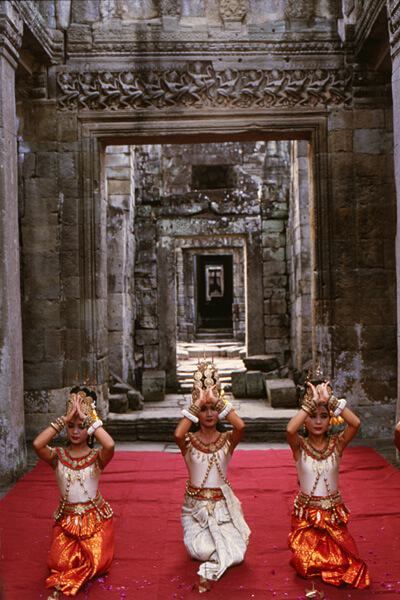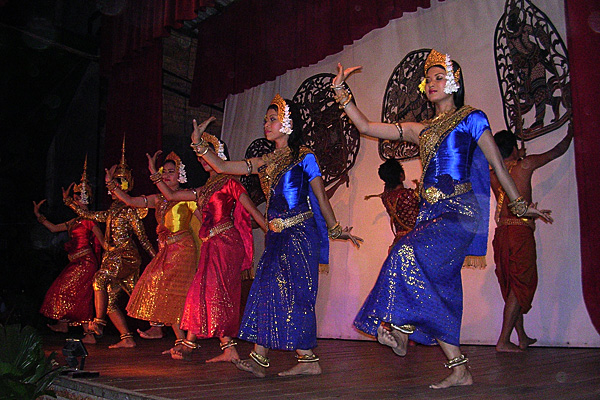The Twentieth Century
Despite the great Royal Dance Troupe’s success at the Marseilles Colonial Exhibition in 1906, dance and dance-drama declined in the early 20th century. A revival started during the 1940s. Prince Sihanouk (later King, Prime Minister, and the Head of State) employed the royal dancers as cultural ambassadors during his visits abroad as well as during the state celebrations. Sihanouk (1922–) is a great admirer of both Cambodian and French culture. He has composed songs in the style of French chanson, made movies and acted in them. The upper classes, familiar with French culture, experimented in drama in a French spirit.
New dances, mainly non-dramatic “pure dances”, were created in the 1940s, while the traditional dance-dramas were often shortened to suit Westernised tastes. In 1962 Sihanouk gave the Royal Dance Troupe the status of a national institution and it got its own theatre building some years later.
After the declaration of independence in 1953, an intensive search for the nation’s roots started. Freedom from centuries of foreign dominance, first Thai and then French, inspired a movement that is often called “Khmerisation”. The origin of the nation’s history was found in the glorious Khmer culture of the Angkorian period.
The Apsara Dance
- The Apsara Dance performed in a temple hall in Angkor Jukka O. Miettinen
- The Apsara Dance performed in a temple hall in Angkor; in the background a relief showing Angkor-period dancing apsaras, which inspired the creation of the dance in the 1960s Jukka O. Miettinen
In the 1960s, in the field of dance, this new nationalism referring to the glory of the Khmer civilization of the Angkor period led to the creation of the Apsara Dance (Robam Apsara), inspired by the dancing apsara figures of the reliefs of the temples of Angkor.
The dance was choreographed by Sihanouk’s mother, Queen Kossamak, in 1962. The first performer of its main apsara was Princess Norodon Buppha Devi. She impersonated Mera, the legendary founder of Cambodia. Mera is surrounded by four to six supporting dancers, all wearing headdresses and ornaments inspired by the Angkor reliefs.
The dance has gained great popularity and has an enormous nationalistic symbolic value. It was created by royal order and the first performer of Mera was a princess, the daughter of the ruler of the country. Because of its royal and nationalistic content, the verses of the song that accompanies it were altered several times to suit the Khmer Rouge and the Vietnamese invaders. After the Khmer Rouge period, the international press announced that the first revived performance of the original Apsara Dance was a sign of the beginning of a new era.
The Apsara Dance is an example of how historical sources can be employed in creating new works, in this case serving nationalism. The creation myth of the Cambodian nation is danced in a pure Thai-influenced classical Cambodia dance style, while the crowns and ornaments, copied from the reliefs of Angkor, refer to the greatness of the ancient Khmer civilisation. The Apsara Dance is probably the most popular of the modern classical dance numbers in today’s Cambodia.
University-Created Folk Dances
The Royal University of Fine Arts of Cambodia was established in 1964. Later, other institutions responsible for dance training, such as the National Conservatory, were also founded. In this academic milieu the traditional folk dances were newly interpreted. The results are beautified and “refined” versions of original folk dances, a phenomenon known in several dance cultures, for example in Europe, Russia, China and other Asian countries.
The idea was that the ethnic traditions should first be studied in their authentic surroundings by academically trained researchers and students and then reshaped to suit modern stages and audiences. The underlying motivation was to strengthen the national identity and teach people to appreciate the cultural expressions of ethnic minorities. The university-created folk dances in Cambodia include examples of several ethnic traditions. Many of the dances focus on the professions of ordinary people, such as the Good Crops Dance and the Fishing Dance.
During and after the Dark Period
In the 1970s, during the political turmoil and the Vietnam War, the royal family was in exile. Dance performances ceased although the training of dancers continued to some extent. It was the beginning of a period of tight censorship, even in the field of theatre and dance. No references to the King or the country’s royal tradition were allowed.
Court dance and dance-theatre were totally banned after the Khmer Rouge took Phnom Penh in 1975. Many dancers and actors did not survive the hardships of the period. After the Vietnamese “liberated” Cambodia in 1979, theatrical activities were again possible, although a new kind of censorship was established. Nationalism was replaced with the glorification of the Liberation. Even the song of the Apsara Dance was rewritten to praise the liberators instead of describing the mythical birth of the nation. Dance troupes were, however, allowed to perform abroad while several refugee dance groups were established in the Unites States and Europe.
After peace had been restored, the royal family returned to Cambodia in 1991. Princess Buppha Devi was appointed Minister of Culture and the close ties between the royal family and the theatrical arts were revived. After his enthronement in 2004, the present king, Norodom Sihamoni (1953– ), has paid attention, among other things, to the continuation of theatrical traditions as well as to their renewal. In fact, he was trained as an actor, film-maker and dancer, in Pyongyang, Prague and Paris.
- A modern tourist show combining shadow theatre and classical dance Ari Huhtala
During the writing of this text, several dance and theatre troupes have been active once more throughout Cambodia. Many of them earn their living by performing to the international tourists who come to see the ruins of Angkor. Thus the most active theatre and dance centre is, besides Phnom Penh, the provincial city of Siem Reap, near Angkor. Classical dance troupes continue their successful tours abroad while only one of the several village lakhon khol groups seems to have survived the long period of war.


